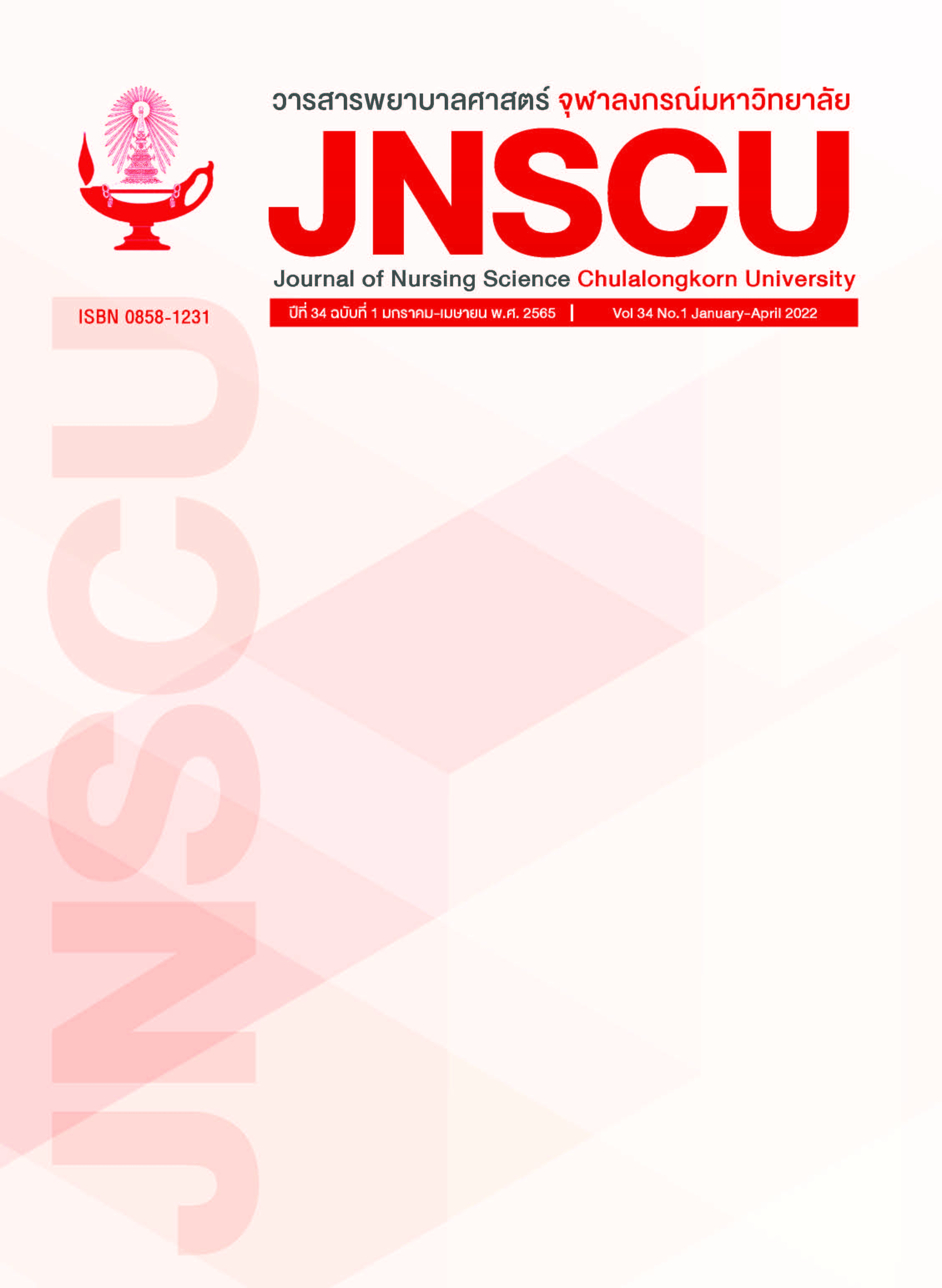ผลของโปรแกรมการจัดการอาการทางลบต่อคุณภาพชีวิต ด้านสุขภาพของผู้ป่วยจิตเภท
คำสำคัญ:
การจัดการอาการทางลบ, คุณภาพชีวิตด้านสุขภาพ, ผู้ป่วยจิตเภทบทคัดย่อ
วัตถุประสงค์: 1) เพื่อเปรียบเทียบคุณภาพชีวิตด้านสุขภาพของผู้ป่วยจิตเภทก่อนและหลังได้รับโปรแกรมการจัดการอาการทางลบ และ 2) เพื่อเปรียบเทียบคุณภาพชีวิตด้านสุขภาพของผู้ป่วยจิตเภทระหว่างกลุ่มที่ได้รับโปรแกรมการจัดการอาการทางลบกับกลุ่มที่ได้รับการพยาบาลตามปกติ
รูปแบบการวิจัย: การวิจัยกึ่งทดลอง
วิธีดำเนินการวิจัย: กลุ่มตัวอย่าง คือ ผู้ป่วยจิตเภทที่ได้รับการรักษาในแผนกผู้ป่วยใน โรงพยาบาลศรีธัญญา ซึ่งมีคุณสมบัติตามเกณฑ์จำนวน 40 คน ได้รับการจับคู่ (Matched pair) และสุ่มเข้ากลุ่มทดลองและกลุ่มควบคุมจำนวนกลุ่มละ 20 คน กลุ่มทดลองได้รับการดูแลตามโปรแกรมการจัดการอาการทางลบที่ผู้วิจัยสร้างขึ้นเป็นระยะเวลา 5 สัปดาห์ ส่วนกลุ่มควบคุมได้รับการพยาบาลตามปกติ เครื่องมือที่ใช้ในการวิจัย คือ 1) โปรแกรมการจัดการอาการทางลบ 2) แบบวัดคุณภาพชีวิตด้านสุขภาพ (SF-36) และ และ 3) แบบประเมินอาการทางจิตโรคจิตเภท ฉบับภาษาไทย เฉพาะอาการทางลบ เครื่องมือทุกฉบับได้รับการตรวจสอบความตรงตามเนื้อหาโดยผู้ทรงคุณวุฒิมีค่าดัชนีความตรงตามเนื้อหาเท่ากับ 0.97 และ 1.0 ตามลำดับ ค่าความเที่ยงสัมประสิทธิ์อัลฟาของครอนบาคเท่ากับ 0.98 และ 0.86 ตามลำดับ วิเคราะห์ข้อมูลโดยใช้สถิติทดสอบที (t-test)
ผลการวิจัย: 1) คุณภาพชีวิตด้านสุขภาพของผู้ป่วยจิตเภทหลังได้รับโปรแกรมการจัดการอาการทางลบสูงกว่าก่อนได้รับโปรแกรม อย่างมีนัยสำคัญทางสถิติที่ระดับ .05 และ 2) คุณภาพชีวิตด้านสุขภาพของผุ้ป่วยจิตเภทกลุ่มที่ได้รับโปรแกรมการจัดการอาการทางลบสูงกว่ากลุ่มที่ได้รับการพยาบาลตามปกติ อย่างมีนัยสำคัญทางสถิติที่ระดับ .05
สรุป: การใช้โปรแกรมการจัดการอาการทางลบในการดูแลผู้ป่วยจิตเภทที่มีอาการทางลบทำให้คุณภาพชีวิตด้านสุขภาพของผู้ป่วยจิตเภทดีขึ้นได้ ซึ่งเป็นไปตามสมมติฐานที่ตั้งไว้
References
WHO. Schizophrenia [Internet]. 2016 [cited
Jan 10]. Available from: URL:
http:// www.who.int/mental-health/
management/schizophrenia/en
Sadock BJ, Sadock AV. Comprehensive
textbook of psychiatry. Philadelphia:
Lippincott. Williams and wilkins; 2017.
Department of Mental Health. Debt
Instrument Annual Report 2016.
Nonthaburi: Beyond Lindissing; 2016.
Srithanya Hospital. Statistical report of the
year 2019. Nonthaburi: Medical Statistical
Work, Planning and Information
Department Srithanya Hospital; 2019.
Ruangtrakul S. Textbook of Psychiatry. 10th
printing. Bangkok: Ruean Kaew Printing.
Chein WT, Norman I. Education needs of
families caring for Chinese patients with
schizophrenia. J Adv Nurs 2003; 44(5) :
-8
Lotrakul M, Sukanich P. Psychiatry Ramathibodi
(4th ed). Bangkok: Department of
Psychiatry, Faculty of Medicine Ramathibodi
Hospital Mahidol University. 2015.;
Siritheptawee A, Uheanwai S, Chumpucha P,
Ratchain S. Quality of life of schizophrenic
patients attending psychosocial therapy
program of Nakhon Ratchasima
rajanagarindra psychiatric hospital.
Journal of Nakhon Ratchasima
Rajanagarindra Psychiatric Hospital
; 12:
Warner S C, Williams JI. The meaning in life
scale: determining the reliability and
validity of a measure. J. Chronic Dis 1987;
(6): 503-12.
Azaiez C, Millier A, Lançon C, Clay E, Auquier
P, Llorca PM, Toumi M. Health related
quality of life in patients having
schizophrenia negative symptoms-a
systematic review. JMAHP 2018; 6(1),
doi: 10.1080/20016689.2018.
Hunter R, Barry S. Negative symptoms and
psychosocial functioning in schizophrenia:
neglected but important targets for
treatment. Eur Psychiatry 2012; 27(6):
-6.
Office of Nursing. Nursing quality indicators
[Internet]. 2011 [cited 2019 July 10].Available from: http://www.dms.moph.
go.th
Chaiyabut K, Uthis P. Selected factors related
to health related quality of life of patient
with schizophrenia and substance use
disorder in community, Central Region.
J Psychiatr Ment Health Nurs 2016; 30(1):
-51. (in Thai)
Suttajit S, Pilakanta S. Predictors of quality
of life among individuals with
schizophrenia. Neuropsychiatr Dis Treat
; 11: 1371-9.doi: 10.2147/NDT.S81024.
Strassnig M, Harvey PD. Treatment of obesity
and disability in schizophrenia.
Innovations in Clinical Neuroscience
; 10(7-8); 15–19.
Abd ELhay ES, Mona A, Mohamed H. The
Effect of Auditory Hallucinations
Management Program on Quality of
Life for Schizophrenic Inpatients, Egypt.
IOSR-JNHS 2017; 6(1): 1-11.
Srithanya Hospital. A manual for caring for
schizophrenic patients in Srithanya
Hospital. Nonthaburi: Srithanya Hospital;
Department of Mental Health, Ministry of
Public Health. Guide to Cognitive
Behavioral Therapy. Nonthaburi: Beyond
Publishing; 2008
Burn N, Grove SK. The practice of nursing
research: Conduct, critique, & utilization
(5th ed). St. Loius, MO: Elsevier Saunders;
Makara-Studzinska M, Wolyniak M, Partyka
I.The quality of life in patients with
schizophrenia in community mental
health service-selected factors. J Pre-Clin
Clin Res 2011; 5(1): 31-4.
Bobes J, Garcia-Portilla MP. Quality of life in
schizophrenia. In: Katschnig H, Freeman
H, Sartorius N, editors. Quality of life in
mental disorders. Chichester UK: John
Wiley and Sons Ltd; 2005. pp. 153–68.
Bobes J, Gonzalez MP. Quality of life in
schizophrenia. In: Kastching H Freeman
H & Satorious N. editor. Quality of life in
mental disorders. New York: John wiley
& sons. 1997.
Kongsakorn, R, Silpakit C. Thai version of
medical outcome study 36 items short
from health survey: An instrument for
measuring clinical results in mental
disorder patients. Rama Med J 2000;
(1): 8-19. (in Thai)
Nilchaikowit T, Kanchanathanalert N,
Srisuraphanon M, Unanong S, Udomrat
P. Positive and Negative Syndrome Scale
Thai varsion (PANSS-T). Nonthaburi:
Department of Mental Health, Ministry
of Public Health.
Soliman ES, Mahdy RS, Fouad HA. Impact of
psychoeducation program on quality of
life of schizophrenic patients and their
caregivers. Egypt J Neurol Psychiat 2018;
(1): 35-41.
Wattanasiri A, Sripusitto S. Continuing Care
Process Development for Schizophrenia
Patients by Interdisciplinary Team and
Caregiver Network, Kamphaeng Phet
Hospital. Journal of Nursing Division
; 40(1): 67-83. (in Thai)
Downloads
เผยแพร่แล้ว
ฉบับ
บท
License

This work is licensed under a Creative Commons Attribution-NonCommercial-NoDerivatives 4.0 International License.
ลิขสิทธิ์ของบทความที่ตีพิมพ์เป็นของวารสารพยาบาลศาสตร์ จุฬาลงกรณ์มหาวิทยาลัย ทั้งฉบับตีพิมพ์เป็นรูปเล่มและเอกสารออนไลน์

